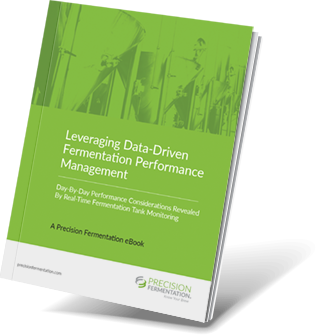Technology & Fermentation: How to Make Your Brewing More Competitive

Brewing has come a long way since its discovery around 12,000 years ago. Not much is known about the methods used to create beverages out of fermented grain at that early date. Some slightly more modern equipment—only about 5000 years old—provides more clues as to the process, but it’s still substantially different from what historians think they know about early brewing.
It’s safe to assume that the art and science behind the brewing industry has changed considerably in the past 5000 years. What’s certainly true in more recent history is that technology in brewing continues to change. Brewing evolution drives beer evolution at a rapid pace — and sometimes it’s the other way around.
Ancient Traditions, Modern Innovations
The modern beer industry has changed considerably, even in the past 30 or 40 years. Before the microbrewery movement in the 1980s, brewing evolution had reached a period of stasis. Besides minor refinements and some economies of scale, brewing was done pretty much as it had been for hundreds of years.
Enterprising brewers in the 1980s brought equipment to the US from Europe or made their own “adjustments” with the help of welding rigs and machine shops. These brewers kept updating their equipment and making minor improvements where they made sense. These little adjustments paved the way for widespread automation throughout the brew industry.
Improvements Through Automation
As the technology in brewing changed, so too did the brews themselves. Automation meant more consistent results across batches, and eventually across breweries and even from brewer to brewer. As brewing evolution continued to advance, brewmasters and beer drinkers benefited from consistent systems and processes that ensured minimal variance in fermentation. This led to higher quality beverages, with overall consistency not seen in the beer industry before.
Greater stability gave brewmasters and brewery owners increased freedom. Brews with longer shelf lives meant a brewery’s output could be tuned to accommodate varying batch sizes, bigger runs of the same brew to generate greater profit or smaller batches that could be tweaked and adjusted. Smaller batches meant running more trials without wasting unnecessary resources. Beverage makers were free to experiment across the entire brew industry.
Progress Is Cool
The importance of refrigeration wasn’t fully understood before the early 1970s. As technology in brewing continued to advance, more and more “minor” improvements added to greater developments and continued successes. Hopping and pelletization improvements further drove beer evolution.
In some cases, brewing drove the advancements. Brewers who imagined hacks that could give them greater control over everything from malting and milling to fermentation were free to adjust their equipment. The adjustments that worked got handed down and talked about, and success led (generally) to success.
Now and Looking Forward
Overall, advances in technology within and outside the brewing industry brought benefits to brewing and beer evolution. Things like lupulin powder became possible through advances in cryogenics. This powder, a purified concentration of essential oils and resins responsible for the flavor and aroma of hops in a brew, provides exciting opportunities for brewmasters to experiment with various aspects of the brewing process.
Other technological advances may not directly improve brews or the brewing process but still bring considerable and essential benefits. Sustainability is no longer an interesting marketing angle or curiosity. Like all efforts to combat climate change, it has become an essential part of what brewers and breweries do. Rippling advantages can lead to lower costs or increased stability and shelf life, but for many, the goal is a lighter load on the land we all share.
Green, responsible production is made more attainable by advances in brewing technology. With smaller, more efficient brewing processes, there is less waste, less energy, and a more sustainable brew from start to finish.
New Opportunities for Innovation
Brewing technology has seen accelerated progress due to the flourishing craft beer movement. As more brewers came to embrace artisanal principles and outlooks, they shared information with their suppliers and vendors—and with each other. Working together, brewers and professionals outside the industry found ways to improve, upgrade, and innovate.
Modern brewers looking for the next growth opportunity keep a keen eye on developing technologies. Competing with other breweries—of all sizes”—has led to a general enthusiasm for and willingness to adopt new tools, methods, and opportunities.
Brewing Technology
Brewing technologies like Precision Fermention’s BrewIQ put unprecedented power in the hands of brewers of any magnitude. The BrewIQ system presents more—and more detailed—information to a brewmaster about every stage of a brew’s development. Important quality metrics can be assessed throughout the fermentation process, and more accurate and precise changes can be implemented.
In real-time, it was impossible to know precisely what a brew’s pH level was, let alone its gravity, pressure, dissolved oxygen numbers, and many other minute details of an ongoing brewing process. Now, that information is available through systems that present constantly updated data about virtually any aspect of the process a brewmaster could wish to monitor.
It’s hard to say what kind of innovation will come about due to these advances. It is a safe assumption that increased information and control over the brewing process will lead to new discoveries—new methods or ingredients—that will result in beverages of higher quality and even greater consistency and stability. To see what’s possible and how Precision Fermenting can help your processes, schedule a live demo today!
Learn more about how to leverage data to optimize your fermentation process.
Free eBook: Leveraging Data-Driven Fermentation Performance Management
Can fermentation management be improved, as a process? This eBook explores, in detail, how fermentation performance data analysis helps elevate product and business outcomes in a modern brewery, whether brewpub, microbrewery or regional craft brewer.
You will learn:
- Day-by-day performance considerations – learned through the extensive examination of real-time fermentation tank data.
- Key recommendations from the Precision Fermentation science team at each major step of fermentation – “Day zero” (i.e. before you pitch your yeast), the first 24 hours, and day two through the end of fermentation.
- Best practices – Activity to watch out for, broken down by each key measurement – Dissolved oxygen, gravity, pH, pressure, internal/external temperature, and conductivity.
- Key findings that can help you solve problems and improve your results.


